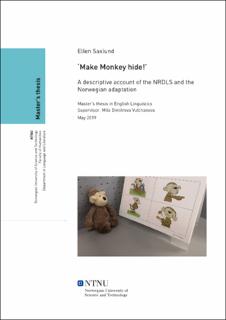| dc.contributor.advisor | Vulchanova, Mila Dimitrova | |
| dc.contributor.author | Saxlund, Ellen | |
| dc.date.accessioned | 2022-02-07T12:21:15Z | |
| dc.date.available | 2022-02-07T12:21:15Z | |
| dc.date.issued | 2019 | |
| dc.identifier.uri | https://hdl.handle.net/11250/2977474 | |
| dc.description.abstract | The New Reynell Developmental Language Scales (NRDLS) is a test instrument intended for use in clinical contexts, primarily for detecting possible atypical language development in children. It is based on several previous versions and revisions of the test, which was published originally in the UK in 1969. In 2017-18, the NRDLS was adapted into Norwegian and standardised for publication and use with a Norwegian-speaking population, for the first time since 1985. The current Norwegian NRDLS was first piloted on a total of 50 children, and for the standardisation and collection of normative data, 242 children between 3:00 and 7:10 years were tested. This thesis aims to be a descriptive account of the NRDLS and its theoretical basis, test adaptation, as well as the process of adaptation and standardisation of the Norwegian NRDLS. When adapting an existing test instrument into a different language, there are several considerations that need to be accounted for. For the NRDLS, the most important was item equivalence and construct equivalence, as well as familiarity with milestones in language development in children. This thesis also discusses some findings from the standardisation process, such as the subtle gender differences in the performance of Norwegian children on the NRDLS, the limited participation of children younger than three years, and possible uses of the NRDLS other than tracking language development in children. | en_US |
| dc.description.abstract | New Reynell Developmental Language Scales (NRDLS) er testverktøy som er tiltenkt bruk i kliniske kontekster, hovedsakelig for å avdekke atypisk språkutvikling hos barn. NRDLS er basert på flere tidligere versjoner og revisjoner av testen, som originalt ble utgitt i Storbritannia i 1969. I 2017-18 ble NRDLS tilpasset og oversatt til norsk og standardisert for bruk på barn med norsk som morsmål, for første gang siden 1985. Den nåværende norske versjonen av NRDLS ble pilottestet på 50 barn med norsk som morsmål. For standardiseringen ble 242 barn mellom 3:00 og 7:10 år testet. Denne oppgaven har til hensikt å være en beskrivelse av NRDLS og dens teoretiske bakgrunn, generelt om tilpasning og oversettelse av testverktøy, i tillegg til tilpasningen og standardiseringen av den norske NRDLS. Man må ta hensyn til flere ting når et testverktøy skal oversettes og tilpasses et annet språk. I NRDLS’ tilfelle var det viktigste hensynet konseptuell ekvivalens, i tillegg til kunnskap om milepæler i språkutviklingen hos barn. Denne oppgaven diskuterer også noen funn fra standardiseringsprosessen, som blant annet subtile kjønnsforskjeller i resultatene hos barn med norsk som morsmål, samt den begrensede deltakelsen av barn under tre år. I tillegg diskuteres mulig bruk av NRDLS utover å kartlegge språkutviklingen hos barn. | en_US |
| dc.language.iso | eng | en_US |
| dc.publisher | NTNU | en_US |
| dc.subject | Master’s thesis in English Linguistics | en_US |
| dc.title | ‘Make Monkey hide!’ - A descriptive account of the NRDLS and the Norwegian adaptation | en_US |
| dc.type | Master thesis | en_US |
